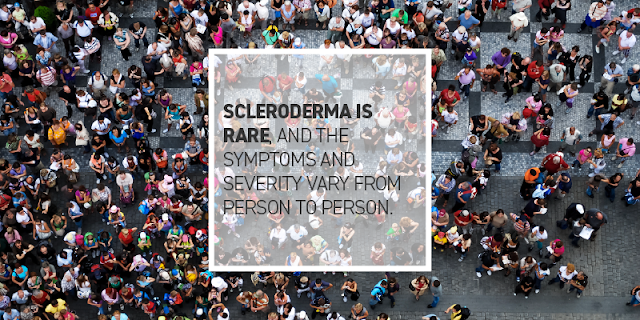As women, we learn that collagen is our friend, particularly if we’re of the “aging” category. Collagen is the most abundant protein in the body and is the main structural protein found in skin and other connective tissues. It’s what helps your skin maintain its shape and structure. You know when your collagen starts to break down: your skin loses its plumpness and develops those pesky fine lines and wrinkles, and healing from scrapes takes longer.
But what happens when collagen seems to go rogue?
What Is Scleroderma?
The name “scleroderma” is derived from Greek: skleros (meaning hard or indurated) and derma (referring to the skin). It literally means thick-skin. It usually mainly affects just the skin, though it may also affect other internal body parts.
According to the Johns Hopkins Scleroderma Center, scleroderma is an illness that causes a hardening of the skin and other connective tissues of the body. It affects the body by changing the connective tissue. This includes collagen and other extracellular components and structures.
When the body tissues, particularly the skin, overproduce and accumulate collagen, scleroderma is the result. It’s a chronic connective tissue disease, generally classified as an autoimmune rheumatic disease, though doctors aren’t quite certain what prompts it. With autoimmune diseases, the body’s immune system causes inflammation and other abnormalities on its own (with no prompting from something like an infection). The immune system is working against you instead of working for you.
Your immune system is like a tiny internal army that fights off invaders (like viruses and bacteria). Sometimes the immune system goes haywire and starts attacking your own body instead. With scleroderma, cells start making collagen as though there was an injury that needs to be healed. Those cells don’t “turn off” like they should and end up making too much collagen, which then gets in the way of the normal functioning of organs like your skin.
Scleroderma is rare, and the symptoms and severity vary from person to person. Not everyone will have all the symptoms. Some people will experience mild symptoms that are more of a bother, like itching and cold fingers. Others experience more severe symptoms that may become life-threatening. It is chronic, meaning there is no cure, but it can be managed, and most people will experience times when the illness improves or goes into remission.
What Does Scleroderma Look Like?
Initially, scleroderma patients’ skin will gradually tighten and thicken or harden, usually in patches. They’ll notice that their skin doesn’t stretch like it used to. These patches may be shaped like ovals or straight lines, or cover wide areas of the trunk and limbs. The skin may appear shiny because of the tightness, and movement of the affected areas may be restricted. It can also harden the blood vessels (sclerosis), which can cause damage to internal organs.
It usually affects the hands, face, and feet, though it can also target the digestive tract, heart and circulatory system, lungs, and kidneys. Men who have scleroderma often experience erectile dysfunction, and women’s sexual function may be affected, because of a decrease in vaginal lubrication and a constriction of the vaginal opening.
There Are Two Main Types of Scleroderma: Limited, and Diffuse
Limited scleroderma, or CREST, is the milder form of the disease and is more common among Caucasians. It’s named for the acronym of its symptoms:
- Calcium deposits in the body tissues
- Raynaud’s phenomenon (a disease manifesting as an exaggerated response to cold temperatures or emotional stress, resulting in numbness, pain, or color changes in fingers or toes)
- Esophageal reflux
- Sclerodactyly (thick skin on the fingers)
- Telangiectasias (enlarged blood vessels, appearing as red spots on the face and other areas)
With the limited form, there may be little skin involvement, and symptoms develop slowly over years. Internal problems can occur, but they are not very frequent and tend to be less severe than in diffuse scleroderma. The musculoskeletal system, gastrointestinal tract, lungs, and heart may be mildly involved. The patient may develop pulmonary hypertension as a result of a narrowing of the lungs’ blood vessels, resulting in shortness of breath.
With the diffuse form, the skin thickening occurs more rapidly and involves more skin areas than in the limited disease. These people have a much higher risk of developing sclerosis (fibrous hardening) of the internal organs. The same organs may be affected, plus the teeth and kidneys may be involved. Some of these complications may be life-threatening in more severe cases.
Treatment for Scleroderma
Treating a chronic illness like scleroderma is complicated. While there is no cure, there are things that can be done to increase a patient’s comfort level. Treatment may even help to control the disease to keep it from getting worse.
The most important thing you can do to help your situation is to learn to communicate effectively with your doctor. Ask questions and be clear in what you are looking to accomplish with your visit. Be forthright with your doctor in your ability and willingness to follow the treatment protocol and advice. Unfortunately, trial-and-error is the only way your doctor can determine what medication will be effective for you. You’ll have to work together and keep your spirits up through the process.
Skin Care Tips From MDSUN Skin Care®
Please Visit Our Official Website - MDSUN Skin Care




Comments
Post a Comment